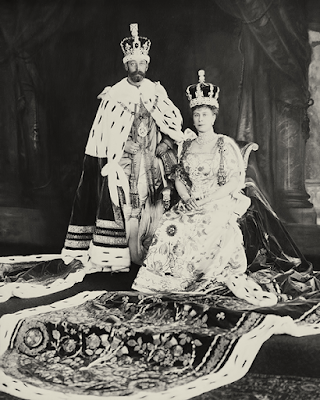Royal Jewelry: Imperial State Crown
The crown of the crowns ...
During the covid pandemic, I really missed the bling moments of the royal families.
I started reading books about royal jewelry and I began to interest me in the history of this famous pieces. So, I hope you'll enjoy next blog post about the Imperial State Crown.
Escpecially during this year of the Platinum Jubilee of The Queen, I hope to catch up with some special jewelry posts.
St Edward's Crown, used to crown English monarchs, was considered to be a holy relic, kept in the saint's shrine at Westminster Abbey and therefore not worn by monarchs at any other time. Instead, a "great crown" with crosses and fleurs-de-lis, but without arches (an open crown), was a king's usual headgear at state occasions until the time of Henry V, who is depicted wearing an imperial crown of state with gold arches (a closed crown).
Arches were a symbol of sovereignty, and by this point in history, the king of England was being celebrated as rex in regno suo est imperator – an emperor of his own domain – owing obedience to no one but God, unlike some continental rulers, who owed fealty to more powerful kings or the Holy Roman Emperor.
Henry VII or his son and successor Henry VIII may have commissioned a more elaborate version of the state crown which is first described in detail in an inventory of royal jewels in 1521, and again in 1532, 1550, 1574 and 1597, and was included in a painting by Daniel Mytens of Charles I in 1631.
The Tudor Crown had more pearls and jewels than its medieval predecessor, and the centre petals of each of the fleurs-de-lis had images of Christ, the Virgin Mary and St George.
The crown weighed 3.3 kg (7 lb 6 oz) and was set with 168 pearls, 58 rubies, 28 diamonds, 19 sapphires and 2 emeralds.Following the abolition of the monarchy and the execution of Charles I in 1649, the Tudor Crown was broken up by Oliver Cromwell during the Interregnum, and its valuable components were sold for £1,100.
Charles II of England with his coronation crown
Upon the restoration of the monarchy in 1660, a new state crown was made for Charles II by Sir Robert Vyner. About 10 versions of the crown have existed since the restoration.
Imperial State Crown for Queen Victoria
Queen Victoria with her coronation jewelry
At the State Opening of Parliament in 1845, the Duke of Argyll was carrying the crown before Queen Victoria when it fell off the cushion and broke. Victoria wrote in her diary, "it was all crushed and squashed like a pudding that had sat down".
The gems in the crown were remounted for the coronation of George VI in 1937 by Garrard & Co.The crown was adjusted for Queen Elizabeth II's coronation in 1953, with the head size reduced and the arches lowered by 25 mm (1 inch) to give it a more feminine appearance.
Facts
The Imperial State Crown is 31.5 cm (12.4 in) tall and weighs 1.06 kg (2.3 lb), and has four fleurs-de-lis and four crosses pattée, supporting two arches topped by a monde and cross pattée. Its purple velvet cap is trimmed with ermine. The frame is made of gold, silver and platinum, and decorated with 2,868 diamonds, 273 pearls, 17 sapphires, 11 emeralds, and 5 rubies.
Notable stones are St Edward's Sapphire on the top cross, reputedly taken from the ring of Edward the Confessor when he was re-interred at Westminster Abbey in 1163, and the Black Prince's Ruby (a large spinel) on the front cross.
In 1909, the 104-carat (21 g) Stuart Sapphire, set in the front of the crown, was moved to the back and replaced by the 317-carat (63 g) Cullinan II.
Below the monde hang four pearls, three of which are often said to have belonged to Queen Elizabeth I, but the association is almost certainly erroneous.
Coronation of King George V and Queen Mary
The use of the crown
The crown is worn by the monarch on leaving Westminster Abbey at the end of his or her coronation.
It is usually also worn at State Openings of Parliament, although Elizabeth II wore a hat in March 1974, June 2017 and December 2019 after snap general elections, and in May 2021; and, in October 2019 she wore the State Diadem, while the Imperial State Crown was carried beside her.
Usually, it is taken to the Palace of Westminster under armed guard in its own carriage and placed in the Robing Room, where the Queen dons her robes and puts on the crown before giving her speech to Parliament. If a State Opening occurs before a coronation, the crown is placed on a cushion beside the monarch. In 1689, one week after being proclaimed king, William III wore his crown in Parliament to pass the Crown and Parliament Recognition Act 1689.
The Tower of London
Only three people are allowed to touch the crown: the monarch, the Archbishop of Canterbury during the coronation ceremony, and the Crown Jeweller, who is responsible for the crown's maintenance, as well as keeping it secure whenever it leaves the Tower of London.
When not in use, the Imperial State Crown is on public display in the Jewel House at the Tower of London.
Coronation of Queen Elizabeth II and Prince Philip
Source pictures: Wikipedia












Comments